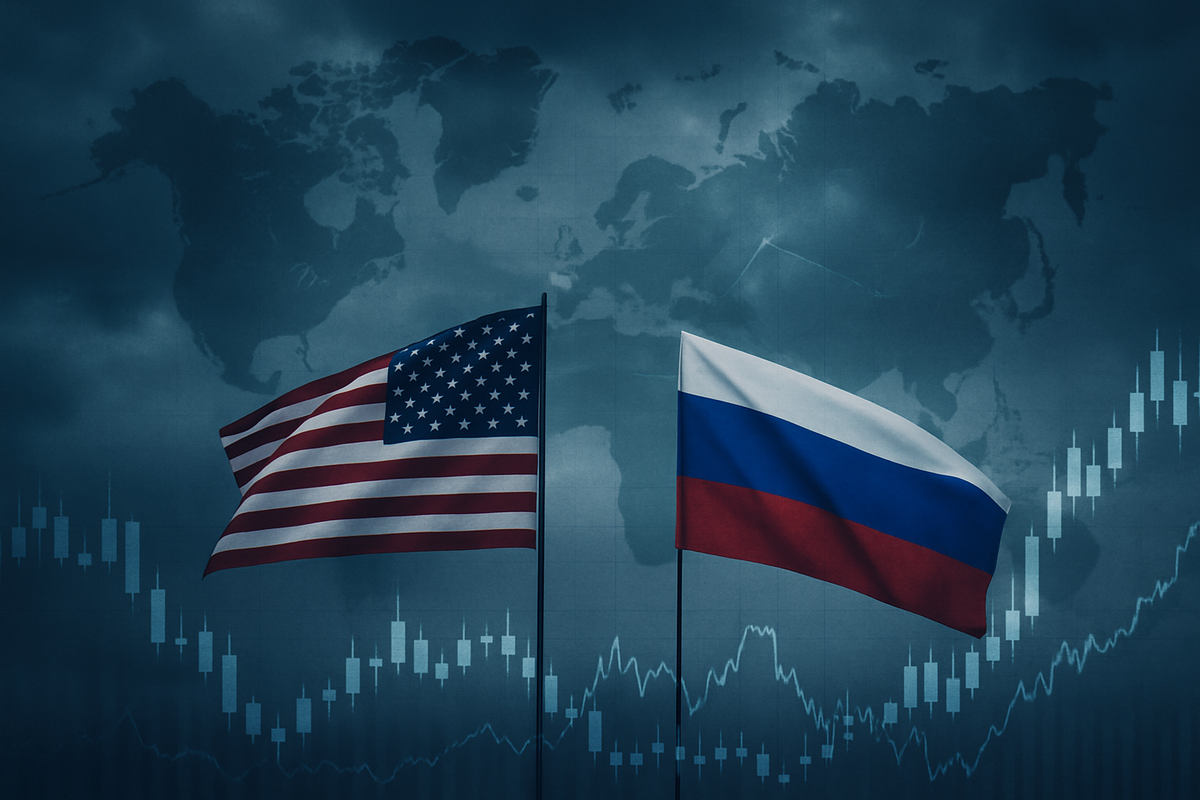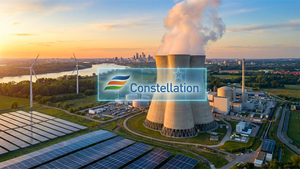
The global financial landscape is once again grappling with the intricate dance of geopolitics, as a recent summit between former U.S. President Donald Trump and Russian President Vladimir Putin in Anchorage, Alaska, on August 15, 2025, has sent ripples of uncertainty and cautious optimism through the markets. While the highly anticipated meeting failed to deliver a major breakthrough in the ongoing Russia-Ukraine war, it did open doors to discussions about Ukraine's security guarantees, signaling a potential, albeit complex, shift in the conflict's trajectory. This development underscores how deeply intertwined international relations are with market stability, influencing investor sentiment and corporate strategies across various sectors.
The Anchorage Accord: A Summit of Nuance, Not Breakthroughs
The August 15th summit, the first face-to-face encounter between Trump and Putin since 2019, was primarily centered on the "settlement of the 'Ukrainian crisis'." Despite former President Trump's initial stated goal of securing an immediate ceasefire, the nearly three-hour discussion concluded without such an agreement. Both leaders offered brief, somewhat ambiguous statements post-summit. Putin alluded to "unspecified agreements," while Trump described the meeting as "extremely productive," yet conceded there remained "sticking points," emphasizing, "There's no deal until there's a deal."
A notable absence from the Alaska talks was Ukrainian President Volodymyr Zelenskyy, despite the discussions directly impacting his nation's future. Zelenskyy had previously advocated for new sanctions against Russia if a ceasefire wasn't achieved and had rejected proposals for territorial concessions in the Donbas region. Conversely, Putin cautioned against any actions that might "torpedo the nascent progress" in the Trump-led peace talks, insisting that a lasting settlement must address "all root causes of the crisis" and "all of Russia's legitimate concerns."
However, a significant development did emerge regarding Ukraine's security. U.S. special envoy Steve Witkoff indicated that President Putin agreed to allow the United States and its European allies to offer Ukraine a security guarantee akin to NATO's collective defense mandate (Article 5-like protection). Witkoff hailed this as a "game-changing" concession, marking the first time Russia had agreed to such a concept. This proposed guarantee would operate outside the formal NATO framework, offered directly by the U.S. and other European nations. European Commission President Ursula von der Leyen welcomed Trump's willingness to contribute, with the "Coalition of the willing" (including the European Union) expressing readiness to participate. While Ukrainian President Zelenskyy expressed gratitude, he stressed the need for clear, practical, and enforceable security arrangements. The summit's unexpected nature and rapid organization reportedly caught Kyiv and its European allies off guard, with critics raising concerns that hosting Putin on U.S. soil might inadvertently legitimize his actions.
Geopolitical Tensions and Market Impact: Winners and Losers in a Shifting Landscape
The protracted Russia-Ukraine conflict, coupled with the nuanced outcomes of the recent US-Russia summit, continues to redraw the lines of profitability across global markets. While the immediate impact on the broader U.S. equity market has been relatively contained, the second-order effects—such as energy price volatility, supply chain disruptions, and inflationary pressures—have created distinct winners and losers, particularly within the defense, energy, and technology sectors.
The most evident beneficiaries of the sustained geopolitical tensions and the emerging discussions around Ukraine's security guarantees are defense contractors. The renewed focus on national security and increased defense spending by NATO allies, with some targeting 5% of GDP by 2035, has fueled a surge in demand for advanced military systems. Lockheed Martin (NYSE: LMT), the world's largest arms producer, has secured multi-billion dollar contracts for programs like JASSM and LRASM missile systems, experiencing substantial growth in its order backlogs across various segments. Similarly, Raytheon (NYSE: RTX), formerly Raytheon Technologies, has seen significant contract awards for AMRAAM missile production, positioning it to benefit from the ongoing need for advanced missile systems and air defense capabilities. Northrop Grumman (NYSE: NOC) has ramped up production of ammunition and other critical military supplies, while General Dynamics (NYSE: GD) has also reported increased sales. European defense firms like BAE Systems (LSE: BAESF) and Rheinmetall (ETR: RHMGF) are also expanding production, with Rheinmetall's stock surging by approximately 1,500% since the conflict began, capitalizing on Europe's rearmament programs. These companies are experiencing increased revenues, robust order backlogs, and potentially higher profit margins, driving strong stock performance.
In the energy sector, while initial volatility impacted traditional markets, the conflict has accelerated Europe's push to reduce reliance on Russian energy, spurring investments in renewable energy and liquefied natural gas (LNG) infrastructure. NextEra Energy (NYSE: NEE), a leading renewable energy company, is capitalizing on the global shift towards green energy, with Eastern Europe emerging as a key growth market. Vestas Wind Systems (CPH: VWS), a Danish wind turbine manufacturer, is also well-positioned to benefit from increased investments in wind power as countries diversify their energy sources. These companies are seeing increased investment and demand, leading to potential revenue growth and expansion of operations.
The conflict has also underscored the critical role of technology in modern warfare. Cybersecurity firms like Palo Alto Networks (NASDAQ: PANW) and CSC (NYSE: CSC) are benefiting from heightened regional tensions, which have increased demand for secure supply chains and digital resilience against state-sponsored cyberattacks. Furthermore, Ukrainian President Zelenskyy's emphasis on investing in Ukraine's military industry, particularly drone production, highlights the "extraordinary" potential for increased production volumes. Companies involved in drone technology and manufacturing could see significant investment and demand, especially those capable of meeting military specifications.
Conversely, companies with significant operations or investments in Russia or Ukraine have borne the brunt of the conflict's economic fallout. Many multinational corporations, including Dell (NYSE: DELL), McDonald's (NYSE: MCD), and Apple (NASDAQ: AAPL), faced immense pressure to withdraw or curtail operations in Russia, leading to substantial financial losses and asset write-downs. American businesses that exited Russia reportedly lost $300 billion over three years. While some withdrawals garnered positive consumer sentiment, the financial cost was considerable. Ukrainian companies, such as Metinvest (LSE: METIN), a major steel company, have suffered direct damage to infrastructure and severe operational disruptions, with Metinvest losing its Azovstal and Illich steelworks in Mariupol. Bunge (NYSE: BG) and Scatec (OSL: SCATC) also suspended operations in Ukraine. These companies have faced severe operational challenges, asset destruction, supply chain disruptions, and reduced revenues, negatively impacting their stock performance.
Even companies that chose to remain or expand operations in Russia, such as SLB (NYSE: SLB, formerly Schlumberger), Coca-Cola Hellenic Bottling Company (LSE: CCH), and Procter & Gamble (NYSE: PG), face significant reputational risks and increasing financial burdens. Ukraine has added some, like Knauf, to its list of "war sponsors." While these companies may continue to generate profits from their Russian operations, they face potential consumer boycotts in other markets and increasing corporate tax rates in Russia, which could lead to long-term negative impacts on brand value and investor sentiment. European energy companies, particularly those heavily reliant on Russian gas imports, have also faced significant challenges due to increased energy prices and supply disruptions, leading to higher operational costs and reduced profit margins.
The emerging discussions about Ukraine's security guarantees are a critical factor for future market dynamics. The formalization of such guarantees, even outside direct NATO membership, is expected to drive sustained demand for advanced defense systems from Ukraine and its European allies, providing a long-term catalyst for defense spending. Furthermore, a durable peace agreement and robust security guarantees are considered prerequisites for unlocking massive reconstruction spending in Ukraine. Construction firms like Bechtel (Private) and Skanska (STO: SKI), and engineering giants such as AECOM (NYSE: ACM), are poised to benefit from the infrastructure boom. Ukrainian companies like Metinvest also stand to gain significantly from increased domestic steel consumption for reconstruction, provided strong security guarantees are in place to attract investment. While private investors are currently hesitant due to security concerns, clear and credible security guarantees would unlock substantial long-term investment in Ukraine's reconstruction, leading to significant revenue opportunities for construction, engineering, and materials companies.
Industry Impact and Broader Implications of the US-Russia Summit
The recent US-Russia summit in Anchorage, Alaska, while not delivering an immediate resolution to the Russia-Ukraine war, has nonetheless set in motion a series of broader industry trends and geopolitical ripple effects. The discussions, particularly around Ukraine's security guarantees, signal a potential recalibration of international relations and a continued reshaping of global economic landscapes.
The energy sector, already in flux due to the conflict, is experiencing further shifts. While the summit saw a temporary stabilization of oil prices, partly due to former President Trump's decision to delay tariffs on Chinese and Indian purchases of Russian oil, a long-term trend of market bifurcation is emerging. Russia is increasingly redirecting its energy exports to Asian markets, potentially leading to higher energy costs for Western economies while Asian buyers benefit from discounted Russian oil. Discussions at the summit also hinted at potential joint ventures in rare earth minerals, particularly in Ukrainian territories under Russian control, and Arctic energy infrastructure, signaling a strategic pivot towards resource-driven partnerships. This ongoing fragmentation of energy supply chains will continue to impact global energy prices and the profitability of energy companies, with those able to adapt to new trade routes and partnerships likely to fare better.
The defense sector, as previously noted, remains a clear beneficiary. The ambiguity surrounding US military support for Ukraine following the summit initially triggered a surge in defense stocks, and while a significant de-escalation could lead to a cooling period, the global trend of surging defense budgets, driven by military Keynesianism and arms races, is likely to persist. This sustained demand for advanced military technologies will continue to benefit major defense contractors. In the finance and technology sectors, the persistence of sanctions means energy markets will remain volatile, necessitating diversified portfolios and hedging tools for investors. There is also an increased demand for software and services related to sanctions compliance, benefiting cybersecurity and financial technology firms. Emerging markets, particularly those maintaining trade ties with Russia like India and Turkey, face a rebalancing of global trade flows and potential capital flight risks as they navigate the complexities of balancing energy security with mitigating the risks of US secondary sanctions.
The summit's outcomes have significant implications for international actors, particularly NATO and European allies. European leaders, including Germany, France, and the UK, have consistently emphasized the need for any peace deal to respect Ukraine's sovereignty and involve Kyiv directly. They are coordinating efforts to present a "united front" to former President Trump and ensure continued support for Ukraine. The potential for US and European security guarantees for Ukraine, outside of NATO's formal framework, could be a strategic compromise to address Russia's objections to Ukraine's NATO membership while still providing Kyiv with robust defense assurances. This "hybrid model" of security, combining U.S. political backing with European military and logistical support, will continue to shape defense spending and capital inflows into the sector.
Historically, US-Russia (and US-Soviet) summits have often marked turning points in global diplomacy. Cold War era summits, such as Geneva (1955) and Reykjavik (1986), were crucial for managing tensions and negotiating arms control agreements, ultimately contributing to the end of the Cold War. While the current geopolitical climate is described as more tense than at any time since the 1980s, the Alaska summit, like its historical predecessors, served as a platform for direct communication between the leaders of two major nuclear powers. However, unlike some Cold War summits that yielded concrete arms control agreements, the Alaska summit concluded without a formal deal on a ceasefire or sanctions relief, highlighting the persistent challenges in resolving the Ukraine conflict. The success of past summits often depended on factors like personal chemistry and domestic politics, elements that were clearly at play in the recent Alaska meeting, underscoring the complex interplay of personalities and national interests in shaping global events.
What Comes Next: Navigating a Shifting Geopolitical Landscape
The recent US-Russia summit, while not delivering an immediate resolution to the Russia-Ukraine war, has undeniably set the stage for a complex and evolving geopolitical landscape. The short-term and long-term possibilities stemming from this meeting will significantly influence strategic alignments, global markets, and the ultimate trajectory of the conflict in Ukraine.
In the immediate aftermath, continued diplomatic engagement appears to be the most likely scenario. Both former President Trump and President Putin have hinted at the possibility of future meetings, with Moscow even suggested as a potential venue. Crucially, Ukrainian President Volodymyr Zelenskyy is scheduled to meet with former President Trump and European leaders in Washington on August 18, 2025, to discuss the war's conclusion and potential security assurances for Ukraine. This indicates a multi-faceted diplomatic effort, even as Russian forces continued offensive operations during and immediately after the summit, underscoring the absence of an immediate ceasefire. The status quo on sanctions against Russia largely remains, though former President Trump's decision on potential secondary tariffs on countries purchasing Russian oil, such as India, remains pending. Initial market reactions have been mixed, with oil prices seeing a slight dip due to eased concerns about further US restrictions on Russian oil, while European defense stocks surged, reflecting persistent geopolitical tensions. Ukraine, for its part, has consistently rejected any territorial concessions and insists on its direct participation in any peace negotiations, actively seeking robust security guarantees from the US and its allies.
Looking further ahead, the summit's outcomes could trigger significant long-term strategic pivots. For the United States, the meeting suggests a potential reorientation of foreign policy, possibly prioritizing counterbalancing China by seeking to create a wedge between Russia and China. Former President Trump's emphasis on a "peace agreement" over a mere ceasefire, potentially involving territorial swaps, signals a willingness to redefine the transatlantic security architecture and explore a normalization of relations with Russia. For Russia, the summit was a significant diplomatic victory, effectively ending its international isolation and reaffirming its status as a "great power." President Putin's long-term objective in Ukraine appears to remain "maximalist and eliminationist," aiming for "complete subjugation if not complete occupation." Russia may continue to use diplomatic overtures to gain time and consolidate territorial gains, while also exploring joint energy and business ventures, particularly in the Arctic, if sanctions are eased.
European nations and NATO face a strategic dilemma. While they have increased defense spending, there's a risk of diminished European influence on security outcomes if the US and Russia pursue bilateral agreements that bypass European concerns. European leaders will need to further enhance their military capabilities and prepare for a scenario where the US redefines its security commitments to the continent. For India, a potential easing of US-Russia tensions could offer greater geopolitical maneuvering room, but the immediate challenge of potential US secondary tariffs on Russian oil purchases remains. China could face increasing geopolitical pressure if the US extends NATO-like security protection to Ukraine, potentially altering the US-China-Russia power dynamic, though a US-Russia agreement on Ukraine could also ease external strategic challenges for Beijing.
Market opportunities and challenges will continue to emerge. If sanctions are eased, there could be opportunities for joint US-Russian energy projects, particularly in the Arctic, which hold vast untapped oil and natural gas reserves, potentially stabilizing global energy markets. For investors, diversification across sectors less correlated with geopolitical risks, such as utilities, healthcare, and technology, along with hedging strategies using energy ETFs and precious metals, will be crucial. However, the persistence of sanctions will likely maintain volatility in energy markets, and geopolitical risk premiums are expected to remain elevated, particularly affecting economies in Eastern Europe and Central Asia. Uncertainty surrounding sanctions enforcement and the potential for new tariffs pose ongoing challenges for businesses and investors. A unilateral US move to ease sanctions could also lead to a fracturing of Western unity, creating further market instability.
The Russia-Ukraine war itself faces several potential scenarios. Former President Trump has publicly shifted his focus to a comprehensive "peace agreement," potentially involving "territorial swaps," a stance that directly contradicts Ukraine's position. Experts suggest that President Putin's fundamental goals in Ukraine remain unchanged, and he may leverage diplomatic engagements to consolidate gains rather than genuinely seeking a compromise. A key element of post-summit discussions involves potential NATO-like security guarantees for Ukraine from the US and European allies, the nature and enforceability of which will be crucial for Ukraine's long-term security. A significant risk following the summit is the potential for a fracturing of Western unity, particularly if the US pursues a path of normalizing relations with Russia or easing sanctions without full European consensus, which could undermine collective pressure on Moscow. The summit underscores the enduring role of great power politics in resolving international conflicts, with the US and Russia potentially attempting to "call the shots" on global security issues. While dialogue is essential to prevent unintentional armed conflict, a fundamental improvement in US-Russia relations is unlikely in the near future given deep-seated conflicts of interest, particularly regarding Ukraine and European security.
Conclusion: Navigating a New Era of Geopolitical Uncertainty
The recent US-Russia summit in Anchorage, Alaska, serves as a stark reminder of the profound and often unpredictable influence of geopolitics on global financial markets. While the meeting did not deliver the immediate ceasefire many hoped for in the Russia-Ukraine war, it has undeniably ushered in a new phase of diplomatic engagement, characterized by nuanced discussions and the potential for strategic realignments. The emerging talks about Ukraine's security guarantees, even outside the formal NATO framework, represent a significant development, signaling a potential pathway towards a more stable, albeit complex, resolution.
Moving forward, investors and businesses must remain acutely aware of the persistent geopolitical risk premiums that will continue to shape market dynamics. The defense sector is poised for sustained growth as nations prioritize national security and rearm. The energy sector will continue its bifurcation, with new trade routes and partnerships emerging as Europe seeks to reduce its reliance on Russian energy, accelerating investments in renewables and LNG. Cybersecurity and drone technology will also see increased demand as the nature of modern warfare evolves. Conversely, companies with significant ties to Russia or Ukraine will continue to face operational challenges, reputational risks, and financial burdens, with their recovery heavily dependent on the cessation of hostilities and the success of reconstruction efforts, which are themselves contingent on credible security guarantees.
The coming months will be critical. Investors should closely monitor the ongoing diplomatic efforts, particularly the upcoming meeting between former President Trump, Ukrainian President Zelenskyy, and European leaders. The specifics of any proposed security guarantees for Ukraine, the potential for further sanctions or their easing, and the broader trajectory of US-Russia relations will all be key indicators. The market will also be watching for any shifts in the conflict's intensity and the potential for large-scale reconstruction efforts in Ukraine, which could unlock significant opportunities for the construction and engineering sectors. Ultimately, the summit underscores that in an increasingly interconnected world, geopolitical events are not isolated incidents but powerful catalysts that can reshape industries, redefine alliances, and fundamentally alter the global economic landscape. Adaptability, diversification, and a keen understanding of international relations will be paramount for navigating this new era of geopolitical uncertainty.






